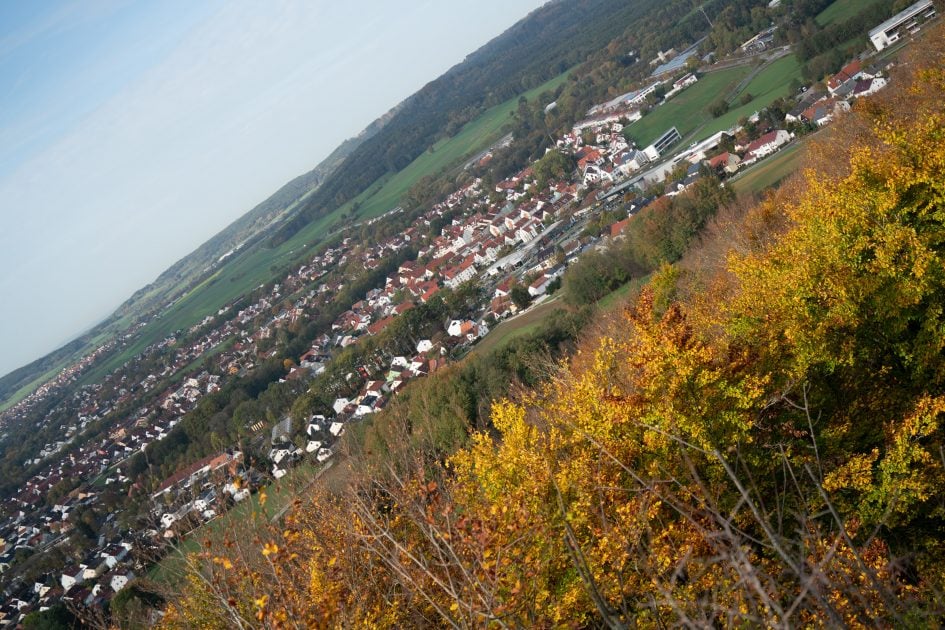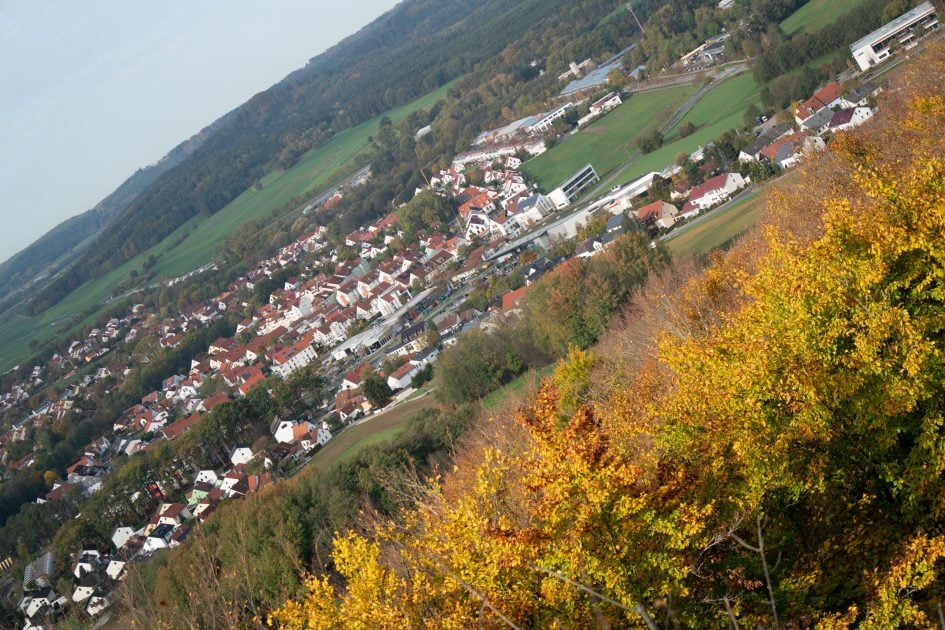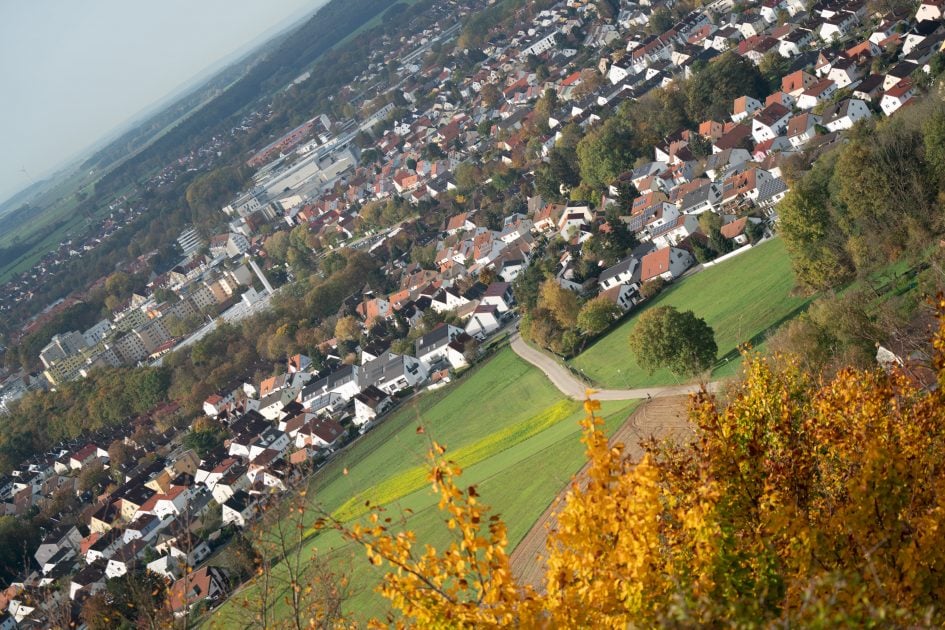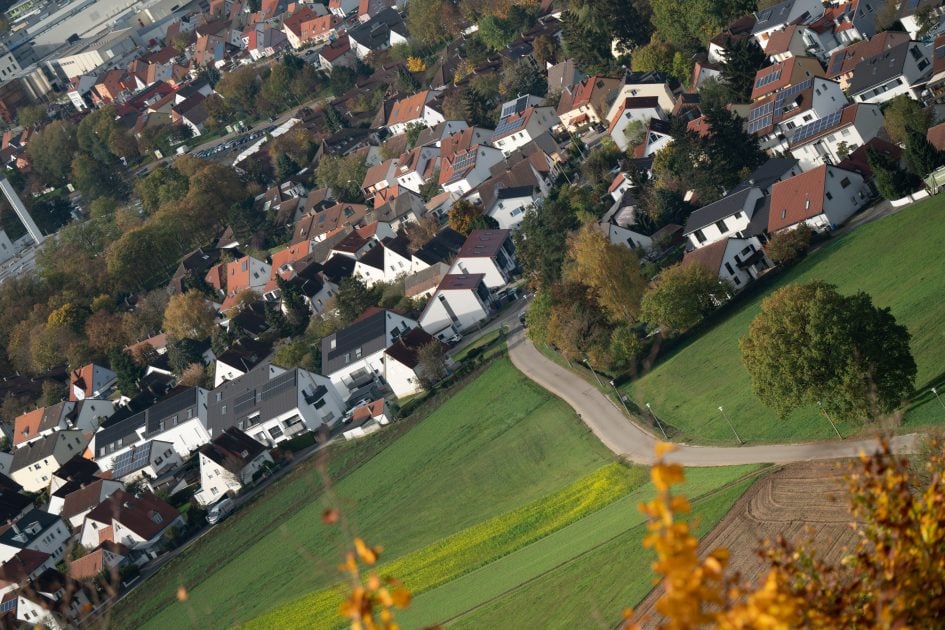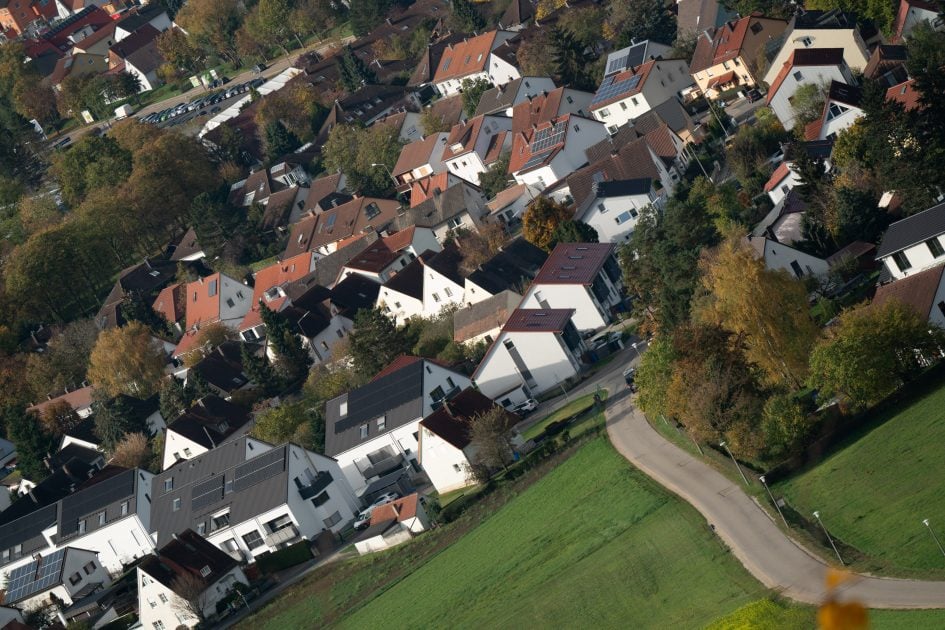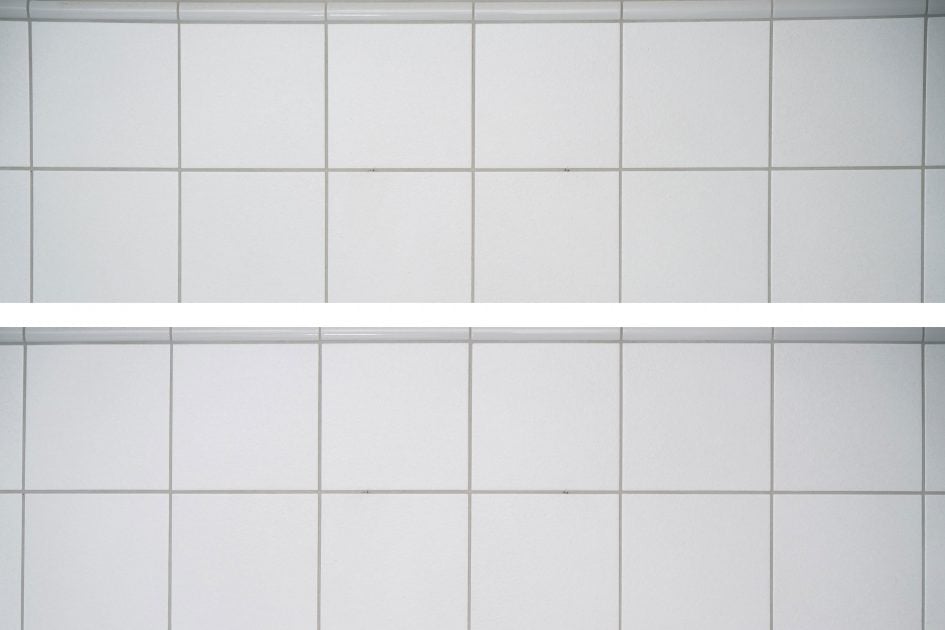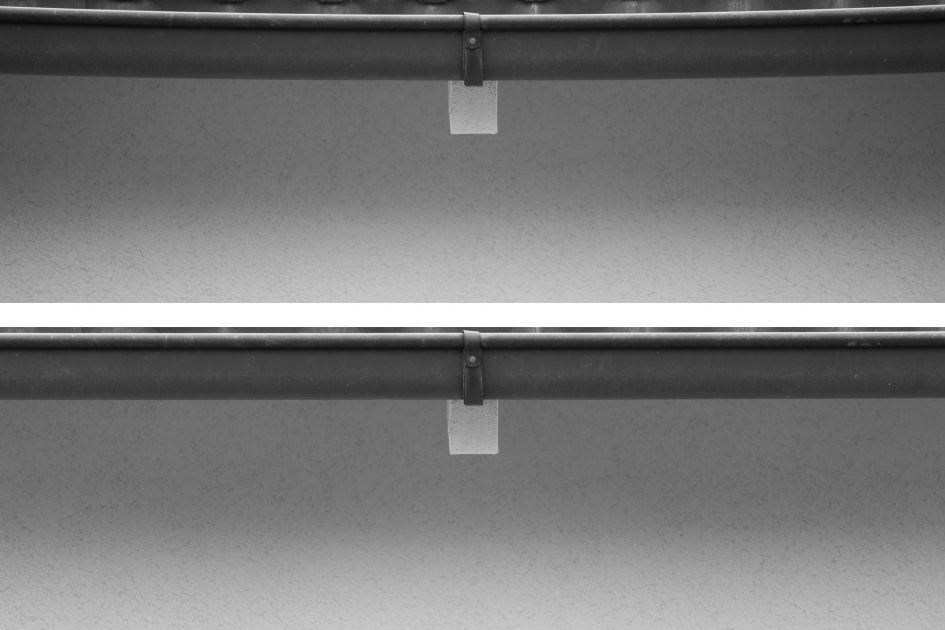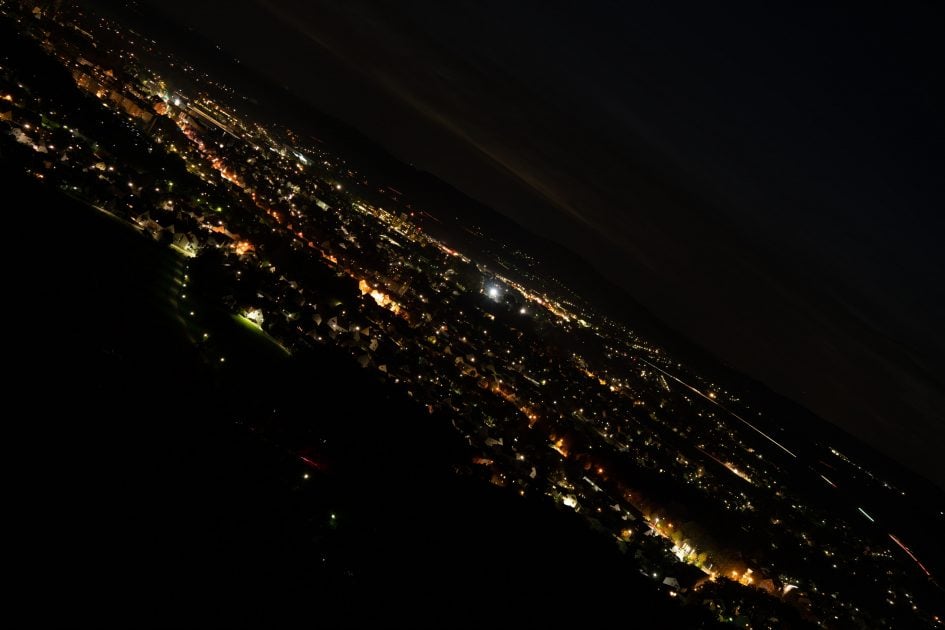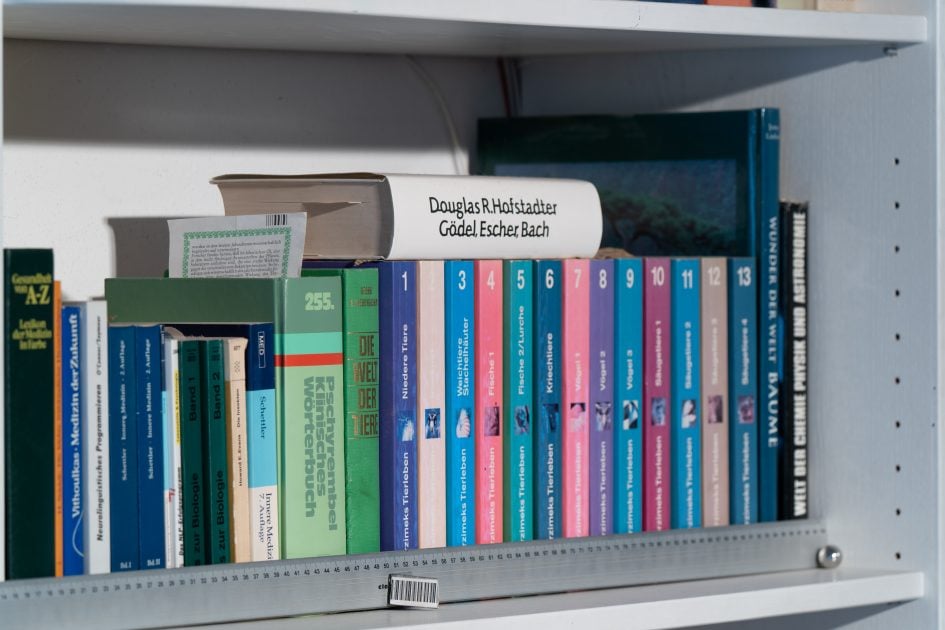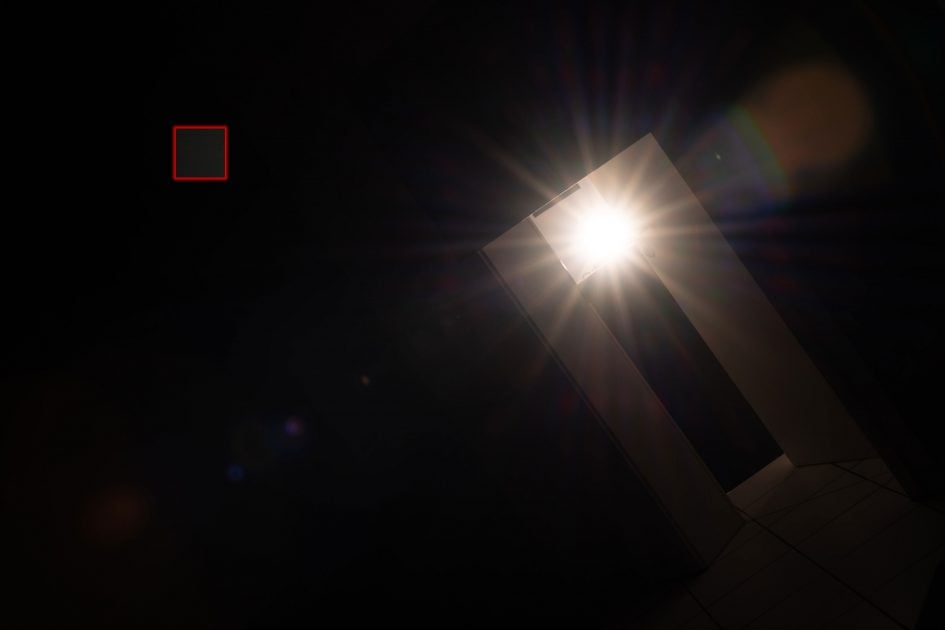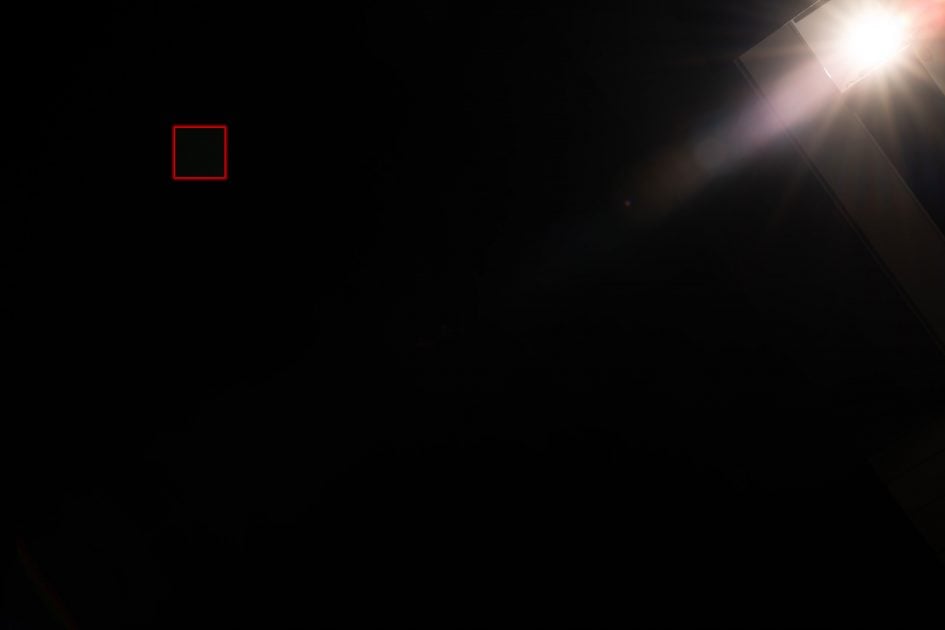Tamron 50-400mm f4.5-6.3 Di III VC review
-
-
Written by Thomas
Quality
Longitudinal Chromatic Aberration and focus shift
Although the Tamron 50-400mm f4.5-6.3 Di III VC has a focal ratio of only f6.3 at the long end I tested for longitudinal color aberrations (loCA, a.k.a. “axial color” or “bokeh CA”). These show up as magenta coloration in the foreground and greenish hues in the background and are not easily corrected in post-processing. The lens shows almost no loCA under these test conditions and there’s no discernible focus shift.
Tamron 50-400mm f4.5-6.3 Di III VC longitudinal Chromatic Aberration (loCA)
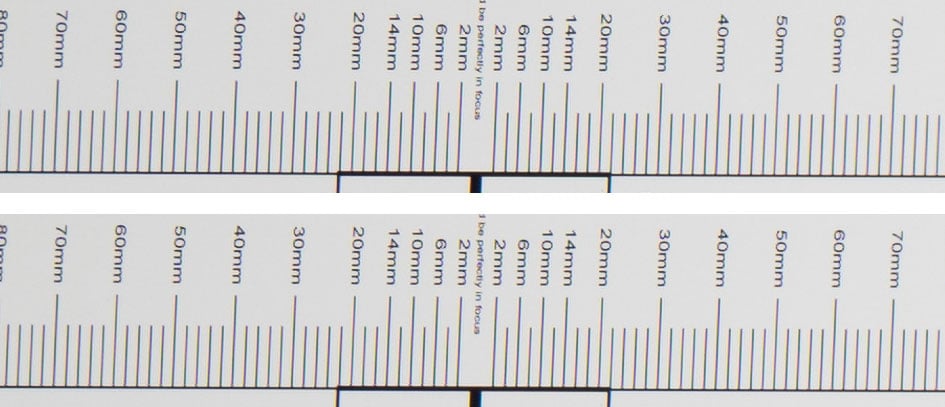
100% crops at 277mm f6.3 (top), f8.0 (bottom); 100% crops, left = foreground, right = background
The following shot shows that the Tamron 50-400mm f4.5-6.3 Di III VC still produces a bit of green outlining around background subjects:

Above: Tamron 50-400mm f4.5-6.3 Di III VC at 102mm f5.6; 100% crop
Sharpness and contrast
Let’s have a look at the theoretical performance of the new Tamron 50-400mm f4.5-6.3 Di III VC and compare it to the Sigma 100-400mm f5-6.3 DG DN OS, Sony FE 100-400mm f4.5-5.6 GM OSS, and Tamron 150-500mm f5-6.7 Di III VC:
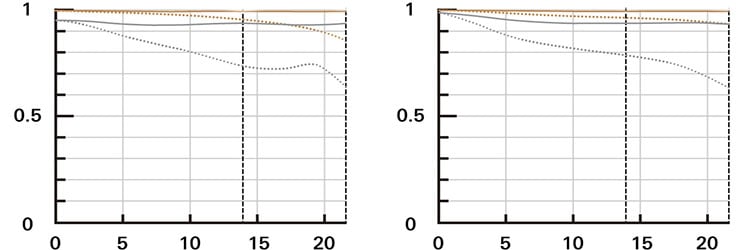
Above: Tamron 50-400mm f4.5-6.3 Di III VC, 50mm f4.5 (left), 400mm f6.3 (right)
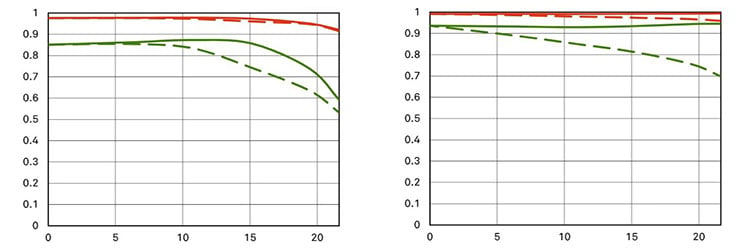
Above: Sigma 100-400mm f5-6.3 DG DN OS, 100mm f5.0 (left), 400mm f6.3 (right)
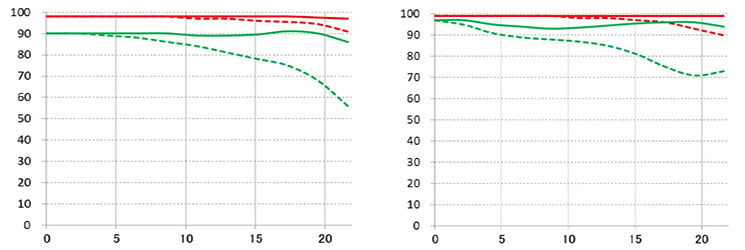
Above: Sony FE 100-400mm f4.5-5.6 GM OSS, 100mm f4.5 (left), 400mm f5.6 (right)
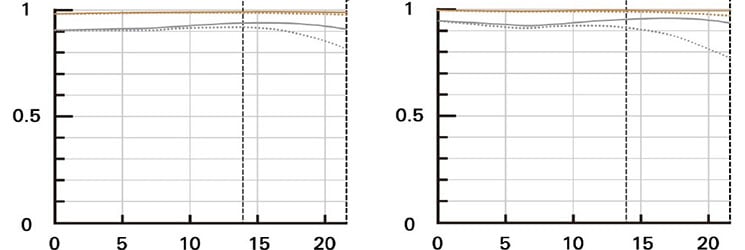
Above: Tamron 150-500mm f5-6.7 Di III VC, 150mm f5.0 (left), 500mm f6.7 (right)
These MTF charts show the computed lens-performance of lenses wide open without influence of diffraction at 10 line-pairs/mm (red) and 30 lp/mm (gray/green). Higher values are better (more contrast) and the closer the dotted and solid lines are together the less contrast dependents on the orientation of the test-pattern (less astigmatism). The x-axis displays the distance from the optical axis (=center of the sensor) in mm.
At the long end the Tamron 50-400mm f4.5-6.3 Di III VC looks similar to the Sigma 100-400, even not much behind the Sony 100-400. At the short end the Tamron 50-400mm starts with a very sharp center but quickly develops stronger astigmatism than the other lenses – but then the Tamron has to cover an 8x zoom-range which is double that of the other lenses.
Let’s see how this theoretical performance translates into real-life results in the sharpness test based on Siemens-stars shot on a 42MP Sony A7R II. Processing was done in Lightroom 12.0/CRAW 15.0 from RAW to Adobe Color profile with the built-in lens profile for CA compensation applied (but no distortion compensation). Noise-reduction is set to 0, sharpening to 50/0.5/36/10, with no extra tone, color, or saturation adjustment. White-balance was adjusted to a neutral white and I did some exposure compensation to make the brightness of all crops match. So you will not see light fall-off in the corners.
The following are all 100% crops!
First up is an overview of the wide-open performance at different focal lengths. You can jump to the detailed results at different apertures and comparisons with other lenses by clicking on the crops of the respective focal length.
Tamron 50-400mm f4.5-6.3 Di III VC; 100% crop from center, APS-C-corner, FF-corner
Above: 50mm, f4.5
Above: 70mm, f5.0
Above: 100mm, f5.6
Above: 200mm, f6.3
Above: 300mm, f6.3
Above: 400mm, f6.3
In the APS-C image-circle the lens looks very sharp throughout the zoom-range with only a slight softening towards the long end. The FF-corner is marred by strong astigmatism at 50mm focal length. It recovers nicely at 70mm already but becomes soft again at 300mm. At its longest focal length of 400mm the lens shows good resolution with an acceptable softening towards the full-frame corner. The lens also exhibits only little field curvature at distances of around 45x focal length especially at the short end. All-in-all these are very satisfying results from an 8x zoom lens.
The following 100% crops for each focal length show the Tamron 50-400mm f4.5-6.3 Di III VC from wide open down to f11 compared to the Tamron 28-75mm f2.8 Di III G2, Tamron 70-180mm f2.8 Di III and Tamron 150-500mm f5-6.7 Di III VC. All three are fine lenses which came Highly Recommended respectively Recommended in my in-depth reviews. I also added the Nikon Z 100-400mm f4.5-5.6 VR S to the comparison as Tamron might either add a Z-mount to their lens or Nikon might build their own lens with Tamron’s optical design in the future. With linear resolution of the 45MP Z7 sensor only 4% higher than from the 42MP A7R II, identical test set-up and identical RAW processing the comparability should be pretty good.
If you want to see all the details and comparisons read on. Or you can fast-forward to the performance at long distances.
Performance at 50mm:
Tamron 50-400mm f4.5-6.3 Di III VC at 50mm compared; 100% crop from center, APS-C-corner, FF-corner

Above: Tamron 50-400mm f4.5-6.3 Di III VC at 50mm, f4.5

Above: Tamron 28-75mm f2.8 Di III G2 at 50mm, f4.0; also available at f2.8, f5.6, f8.0, f11

Above: Tamron 50-400mm f4.5-6.3 Di III VC at 50mm, f5.6

Above: Tamron 50-400mm f4.5-6.3 Di III VC at 50mm, f8.0; also available at f11
At 50mm the Tamron 50-400mm f4.5-6.3 Di III VC is almost as sharp as the very good Tamron 28-75mm f2.8 Di III G2. Only the FF-corner of the shorter zoom looks a bit better. Unfortunately, the astigmatism of the FF-corner does not show much improvement when the lens is stopped down.
Performance at 70mm:
Tamron 50-400mm f4.5-6.3 Di III VC at 70mm compared; 100% crop from center, APS-C-corner, FF-corner

Above: Tamron 50-400mm f4.5-6.3 Di III VC at 70mm, f5.0

Above: Tamron 50-400mm f4.5-6.3 Di III VC at 70mm, f5.6

Above: Tamron 28-75mm f2.8 Di III G2 at 75mm, f5.6; also available at f2.8, f4.0, f8.0, f11

Above: Tamron 70-180mm f2.8 Di III at 70mm, f5.6; also available at f2.8, f4.0, f8.0, f11

Above: Tamron 50-400mm f4.5-6.3 Di III VC at 70mm, f8.0; also available at f11
At 70mm the Tamron 50-400mm f4.5-6.3 Di III VC is sharper than the Tamron 28-75mm f2.8 Di III G2 outside the center but falls a bit behind the Tamron 70-180mm f2.8 Di III.
Performance at 100mm:
Tamron 50-400mm f4.5-6.3 Di III VC at 150mm compared; 100% crop from center, APS-C-corner, FF-corner

Above: Tamron 50-400mm f4.5-6.3 Di III VC at 100mm, f5.6

Above: Tamron 70-180mm f2.8 Di III at 105mm, f5.6; also available at f2.8, f4.0, f8.0, f11

Above: Nikon Z 100-400mm f4.5-5.6 VR S shot on a Nikon Z7 at 100mm, f5.6; also available at f4.5, f8.0, f11

Above: Tamron 50-400mm f4.5-6.3 Di III VC at 100mm, f8.0; also available at f11
At 100mm the Tamron 50-400mm f4.5-6.3 Di III VC is almost as sharp as the Tamron 70-180mm f2.8 Di III and Nikon Z 100-400mm f4.5-5.6 VR S in the APS-C image-circle.
Performance at 200mm:
Tamron 50-400mm f4.5-6.3 Di III VC at 200mm compared; 100% crop from center, APS-C-corner, FF-corner

Above: Tamron 50-400mm f4.5-6.3 Di III VC at 200mm, f6.3

Above: Tamron 70-180mm f2.8 Di III at 180mm, f5.6; also available at f2.8, f4.0, f8.0, f11

Above: Tamron 150-500mm f5-6.7 Di III VC at 200mm, f5.6; also available at f5.0, f8.0, f11

Above: Nikon Z 100-400mm f4.5-5.6 VR S shot on a Nikon Z7 at 200mm, f5.6; also available at f5.0, f8.0, f11

Above: Tamron 50-400mm f4.5-6.3 Di III VC at 200mm, f8.0; also available at f11
At 200mm the Tamron 50-400mm f4.5-6.3 Di III VC is a bit less sharp than the Tamron 70-180mm f2.8 Di III, comparable to the Nikon Z 100-400mm f4.5-5.6 VR S, but sharper than the Tamron 150-500mm f5-6.7 Di III VC inside the APS-C image-circle.
Performance at 300mm:
Tamron 50-400mm f4.5-6.3 Di III VC at 300mm compared; 100% crop from center, APS-C-corner, FF-corner

Above: Tamron 50-400mm f4.5-6.3 Di III VC at 300mm, f6.3

Above: Tamron 150-500mm f5-6.7 Di III VC at 300mm, f5.6; also available at f8.0, f11

Above: Nikon Z 100-400mm f4.5-5.6 VR S shot on a Nikon Z7 at 300mm, f5.6; also available at f5.3, f8.0, f11

Above: Tamron 50-400mm f4.5-6.3 Di III VC at 300mm, f8.0; also available at f11
At 300mm the FF-corner of the Tamron 50-400mm f4.5-6.3 Di III VC is clearly less sharp than from the Tamron 150-500mm f5-6.7 Di III VC or Nikon Z 100-400mm f4.5-5.6 VR S – even when stopped down to f11. But other than that, the 8x zoom hold up quite well even besting both alternatives it in the center.
Performance at 400mm:
Tamron 50-400mm f4.5-6.3 Di III VC at 400mm compared; 100% crop from center, APS-C-corner, FF-corner

Above: Tamron 50-400mm f4.5-6.3 Di III VC at 400mm, f6.3

Above: Tamron 150-500mm f5-6.7 Di III VC at 400mm, f6.3; also available at f8.0, f11

Above: Nikon Z 100-400mm f4.5-5.6 VR S shot on a Nikon Z7 at 400mm, f5.6; also available at f8.0, f11

Above: Tamron 50-400mm f4.5-6.3 Di III VC at 400mm, f8.0; also available at f11
At 400mm the Tamron 50-400mm f4.5-6.3 Di III VC is slightly sharper in the APS-C image-circle wide open than the Tamron 150-500mm f5-6.7 Di III VC and comes pretty close to the Nikon Z 100-400mm f4.5-5.6 VR S. and profits clearly from stopping down to f8.0.
Competing against three good Tamron lenses with much narrower zoom-ranges the new 50-400mm f4.5-6.3 Di III VC shows that Tamron has indeed developed a convincing optical formula for their new 8x zoom lens.
Performance at long distances
The Siemens-star test-targets are shot at a distance of 45x focal length (i.e., at around 18m for 400mm focal length). But performance of lenses also depends on the shooting distance. Therefore, I present another series of images shot on a 42MP Sony A7R II of a city around 1 km away. Processing was done in Lightroom 12.0/CRAW 15.0 from RAW to Adobe Color profile with Adobe’s lens profile compensating distortions but not vignetting. Noise-reduction is set to 0, sharpening to 50/0.5/36/10, with no extra tone, color, or saturation adjustment. All shots were made from a heavy tripod with image stabilization switched off. As usual I have selected the diagonal that provided the better corner results.
The following images show the complete scene wide open plus 100% crops from the center, APS-C-corner, and FF-corner shot with the Tamron 50-400mm f4.5-6.3 Di III VC. You can access the large originals but please respect our copyright and only use those images for personal use.
Tamron 50-400mm f4.5-6.3 Di III VC at 50mm

Above: Tamron 50-400mm f4.5-6.3 Di III VC at 50mm, f4.5; click image for 4k version, here for large original; crops also available at f5.6, f8.0, f11
Tamron 50-400mm f4.5-6.3 Di III VC at 70mm

Above: Tamron 50-400mm f4.5-6.3 Di III VC at 70mm, f5.0; click image for 4k version, here for large original; crops also available at f5.6, f8.0, f11
Tamron 50-400mm f4.5-6.3 Di III VC at 100mm

Above: Tamron 50-400mm f4.5-6.3 Di III VC at 100mm, f5.6; click image for 4k version, here for large original; crops also available at f8.0, f11
Tamron 50-400mm f4.5-6.3 Di III VC at 200mm

Above: Tamron 50-400mm f4.5-6.3 Di III VC at 200mm, f6.3; click image for 4k version, here for large original; crops also available at f8.0, f11
Tamron 50-400mm f4.5-6.3 Di III VC at 300mm

Above: Tamron 50-400mm f4.5-6.3 Di III VC at 300mm, f6.3; click image for 4k version, here for large original; crops also available at f8.0, f11
Tamron 50-400mm f4.5-6.3 Di III VC at 400mm

Above: Tamron 50-400mm f4.5-6.3 Di III VC at 400mm, f6.3; click image for 4k version, here for large original; crops also available at f8.0, f11
The Tamron 50-400mm f4.5-6.3 Di III VC looks very good up to 300mm focal length. Even the astigmatism in the FF-corner at 50mm does not look too bothersome. Only at 400mm the lens softens up a bit but still delivers satisfying results. Stop down to f8.0 to improve acuity visibly.
Vignetting and distortions
To make it easier to see light fall-off in the corners of a full-frame sensor I’ve arranged a series of three shots each with the Tamron 50-400mm f4.5-6.3 Di III VC at 50mm and 400mm focal length, different apertures, and focused to infinity. Surprisingly neither JPGs straight out of camera nor RAW files developed to my usual standard (in Lightroom 12.0/CRAW 15.0) showed any effect from the setting of Shading compensation in camera: they all looked like compensation was Off. See the following images (1st row). To reduce vignetting, I had to activate the Adobe-supplied lens profile (2nd row). All images were developed to the same brightness in the center.
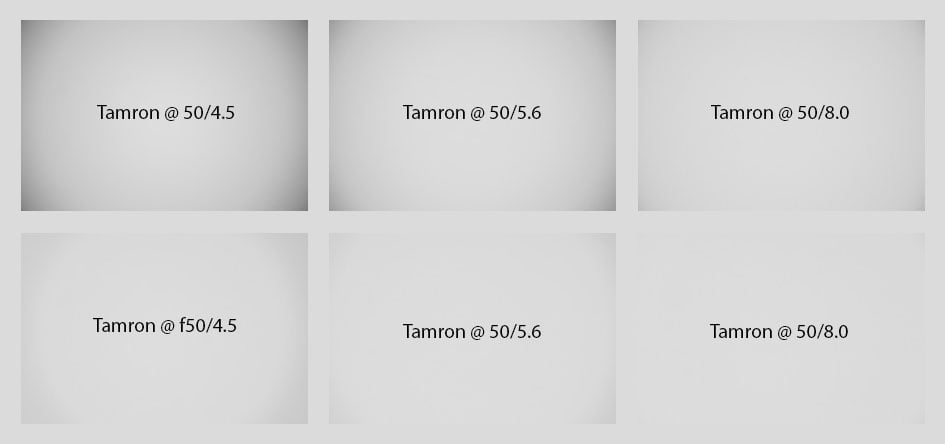
Above: Tamron 50-400mm f4.5-6.3 Di III VC at 50mm; vignetting correction from Adobe lens profile Off (top), 100% (bottom)
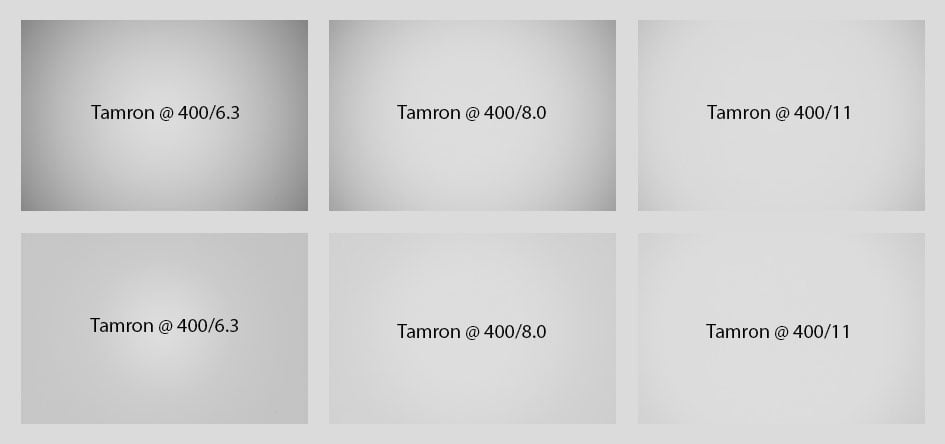
Above: Tamron 50-400mm f4.5-6.3 Di III VC at 400mm; vignetting correction from Adobe lens profile Off (top), 100% (bottom)
In this test vignetting wide open looks relatively strong at both focal lengths but in real-life shooting I found the effect not too bothersome. Applying the lens profile at 100% appears a bit artificial – at setting of 50% looks more natural in my opinion. With vignette correction set to 100% the extreme corners are lifted about 1.3 EV at 50mm and 1.2 EV at 400mm focal length when the aperture is wide open. This is indeed a huge amount compared to other lens profiles which lift the corners by around 0.7 EV.
Distortions are of pincushion type throughout the zoom-range. The setting for Distortion compensation in camera does indeed influence JPGs straight out of camera (as opposed to Shading compensation) but is currently ignored by Adobe’s RAW converter and treated as Off. This again is surprising as I’m used to seeing this setting treated as On. But this is not a problem because you can choose how much distortion correction you apply in Adobe’s lens profile. Setting it to 100% achieves the same effect for RAWs as switching Distortion compensation in camera to Auto has on JPGs.
Distortions: Tamron 50-400mm f4.5-6.3 Di III VC at 50mm; distortion correction from Adobe lens profile Off (top), 100% (bottom)
Distortions: Tamron 50-400mm f4.5-6.3 Di III VC at 400mm; distortion correction from Adobe lens profile Off (top), 100% (bottom)
Distortion correction through Adobe’s lens profile works quite well at the long end but seems to overcompensate a bit at 50mm.
Rendering of point-light sources at night-shots
Night-shots pose a different challenge for lenses as the contrast is even higher than under bright sun and point-light sources can reveal some weaknesses such as coma, haloing and colour-aberrations that do not show up as prominently in other test-shots. The 100% crops below the main image show the effect of coma in the FF-corner of the Tamron 50-400mm f4.5-6.3 Di III VC at different apertures:
Above: Tamron 50-400mm f4.5-6.3 Di III VC at 100mm, f4.5; click image for 4k version, here for large original

Above: Tamron 50-400mm f4.5-6.3 Di III VC at 50mm; 100% crops from the FF-corner at f4.5 (left), f5.6 (middle), f8.0 (right)
The Tamron 50-400mm f4.5-6.3 Di III VC produces very little coma even wide open. The test also shows no color artifacts around bright streetlights.
Bokeh quality
This test is for the rendering of point-light sources in an out-of-focus background. The circle of confusion that is produced by the test is pretty indicative of Bokeh performance (in the background) and light fall-off. Ideally the out-of-focus image of the point-light is evenly lit and perfectly circular, with no “onion-rings”, and without coloration. Large aperture lenses normally produce an effect known as “cat’s eye” the further away from the optical axis the point-light is projected. This is due to optical vignetting in the lens barrel when light enters the lens from an angle.
The crops below the main image are from the center, APS-C-corner, and FF-corner of the 4k version.
Above: Tamron 50-400mm f4.5-6.3 Di III VC at 400mm, f6.3; click image for 4k version
Above: Tamron 50-400mm f4.5-6.3 Di III VC at 400mm, f6.3; click image for 100% crop
Above: Tamron 50-400mm f4.5-6.3 Di III VC at 400mm, f8.0; click image for 100% crop
Above: Tamron 50-400mm f4.5-6.3 Di III VC at 400mm, f11; click image for 100% crop
The diameter of the Bokeh balls in the center is determined by the entrance pupil of the lens. This is 63mm for the new Tamron at 400mm focal length which is only slightly smaller than the 71mm of a 400mm lens with a focal ratio of f5.6. Compression of the circle towards the corners is relatively strong wide open – even at the APS-C corner. The circle of confusion in the center stays round even down to f11. The inside of the Bokeh balls is only lightly textured but there is some outlining – albeit without coloration from loCA.
Let’s see how this analysis of out-of-focus point-light sources translates into Bokeh-performance shooting a bookshelf. Crops are from the foreground, middle-ground, and background resized to make them comparable across all my reviews. I used the longest focal length that I could to produce a comparable shot to my other reviews which was 177mm in the case of the Tamron 50-400 and 165mm for the Tamron 70-180mm f2.8 Di III to achieve the same magnification.
Above: Tamron 50-400mm f4.5-6.3 Di III VC at 177mm, f6.3; click image for 4k version, here for large original
Above: Tamron 50-400mm f4.5-6.3 Di III VC at 177mm, f6.3; click image for 4k version, here for large original
Above: Tamron 70-180mm f2.8 Di III at 165mm, f2.8; click image for 4k version, here for large original
Clearly the over 2 stops brighter focal ratio of the 70-180mm f2.8 Di III (f2.8 vs. f6.3) produces the softer Bokeh especially in the middle-ground and the background. Double contours are hardly a problem as can be seen in another crop (now at 100%) from the same images showing the ruler or a crop from a real-life shot below:
Above: Tamron 50-400mm f4.5-6.3 Di III VC at 177mm, f6.3; click image for 4k version, here for large original
Above: Tamron 70-180mm f2.8 Di III at 165mm, f2.8; click image for 4k version, here for large original
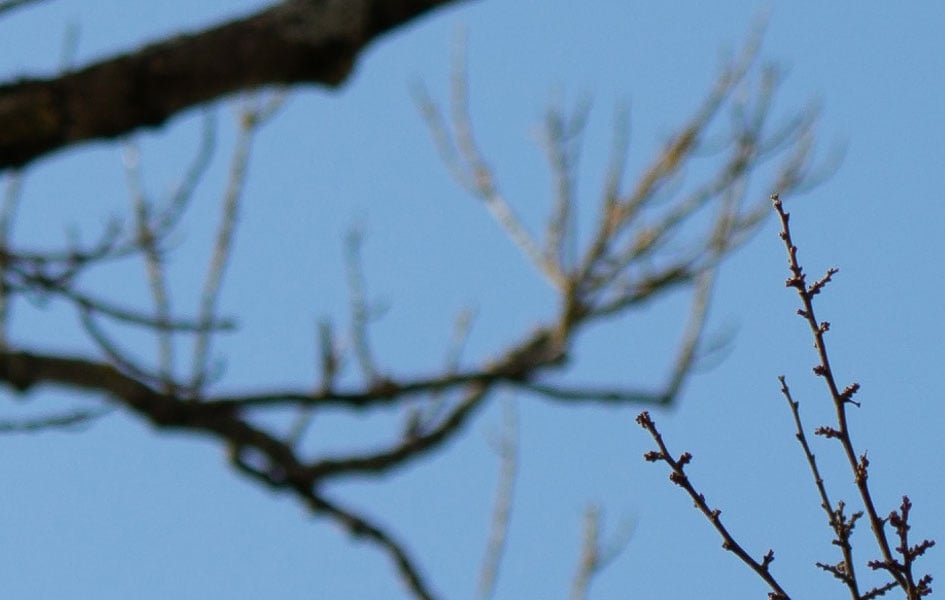
Above: Tamron 50-400mm f4.5-6.3 Di III VC at 50mm, f4.5; 100% crop from near center
Close-up performance
The Tamron 50-400mm f4.5-6.3 Di III VC achieves a very good maximum magnification of 1:2 in close-up shooting at 50mm focal length where the area of sharp focus is just 48 x 72mm or around 1:4 at 400mm focal length covering 96 x 144mm. The crops shown below are from 0mm, 13mm, and 19mm off the center of the sensor respectively.
Tamron 50-400mm f4.5-6.3 Di III VC at 50mm, 1:3.9 magnification; 100% crops

Above: Tamron 50-400mm f4.5-6.3 Di III VC at 50mm, f4.5

Above: Tamron 50-400mm f4.5-6.3 Di III VC at 50mm, f5.6

Above: Tamron 50-400mm f4.5-6.3 Di III VC at 50mm, f8
At 50mm focal length the Tamron 50-400mm f4.5-6.3 Di III VC produces very usable results in the center but becomes mushy pretty fast towards the corners even when stopped down to f8.0. This is in part due to field curvature: The following crops which were specifically focused at 19mm image height clearly look better. But still: best stop down to f8 or beyond if you want satisfying sharpness in close-up shooting at 50mm.

Above: Tamron 50-400mm f4.5-6.3 Di III VC at 50mm, f4.5, f5.6, f8
At 400mm field curvature is very low and things look much better outside the center even wide open. I’d still recommend stopping down to f8.0 to lift contrast a bit:
Tamron 50-400mm f4.5-6.3 Di III VC at 400mm, 1:3.8 magnification; 100% crops

Above: Tamron 50-400mm f4.5-6.3 Di III VC at 400mm, f6.3

Above: Tamron 50-400mm f4.5-6.3 Di III VC at 400mm, f8.0
Flare, ghosting, and sun-stars
Catching a strong light-source shining directly into the lens is always a risky business: it could produce strange colorful ghost-images or reduce contrast considerably through flare and glare. The appearance of flare and ghosting depends on factors like the aperture and the angle of the light hitting the lens. So, to judge the proclivity of Tamron’s 50-400mm f4.5-6.3 Di III VC for these artifacts I went through a series of well calculated shots against a strong light source to provoke glare and ghosting. I tested the lens only at the wide end where the risk of capturing the sun inside the frame is highest. The lens hood was mounted in all shots. Following are two of the more extreme example results. The little bright square inset in the upper left shows the respective area with an exposure compensation of +3 EV to make it easier to see which levels of black the lens renders at that point:
Above: Glare and ghosting from strong light hitting the Tamron 50-400mm f4.5-6.3 Di III VC at 50mm, f11; click image for 4k version or here for +3 EV exposure compensation
Above: Flare from strong light hitting the Tamron 50-400mm f4.5-6.3 Di III VC at 50mm, f11; click image for 4k version or here for +3 EV exposure compensation
The Tamron 50-400mm f4.5-6.3 Di III VC shows some ghosting artifacts and suffers a bit from veiling glare when the light-source is inside the frame – but not overly so. The usual flare when the light source is at the FF-corner is also relatively well controlled. Be aware though that the risk of flare, glare and ghosting increases the further you zoom in.
At the wide end the lens produces sunstars already at f5.6:

Above: Sunstars from the Tamron 50-400mm f4.5-6.3 Di III VC at 50mm, f5.6 (left), f8.0 (right), 100% crops
Next check out my sample images!
Check prices on the Tamron 50-400mm f4.5-6.3 Di III VC VXD at B&H, Adorama, WEX UK or Calumet.de. Alternatively get yourself a copy of my In Camera book, an official Cameralabs T-shirt or mug, or treat me to a coffee! Thanks!